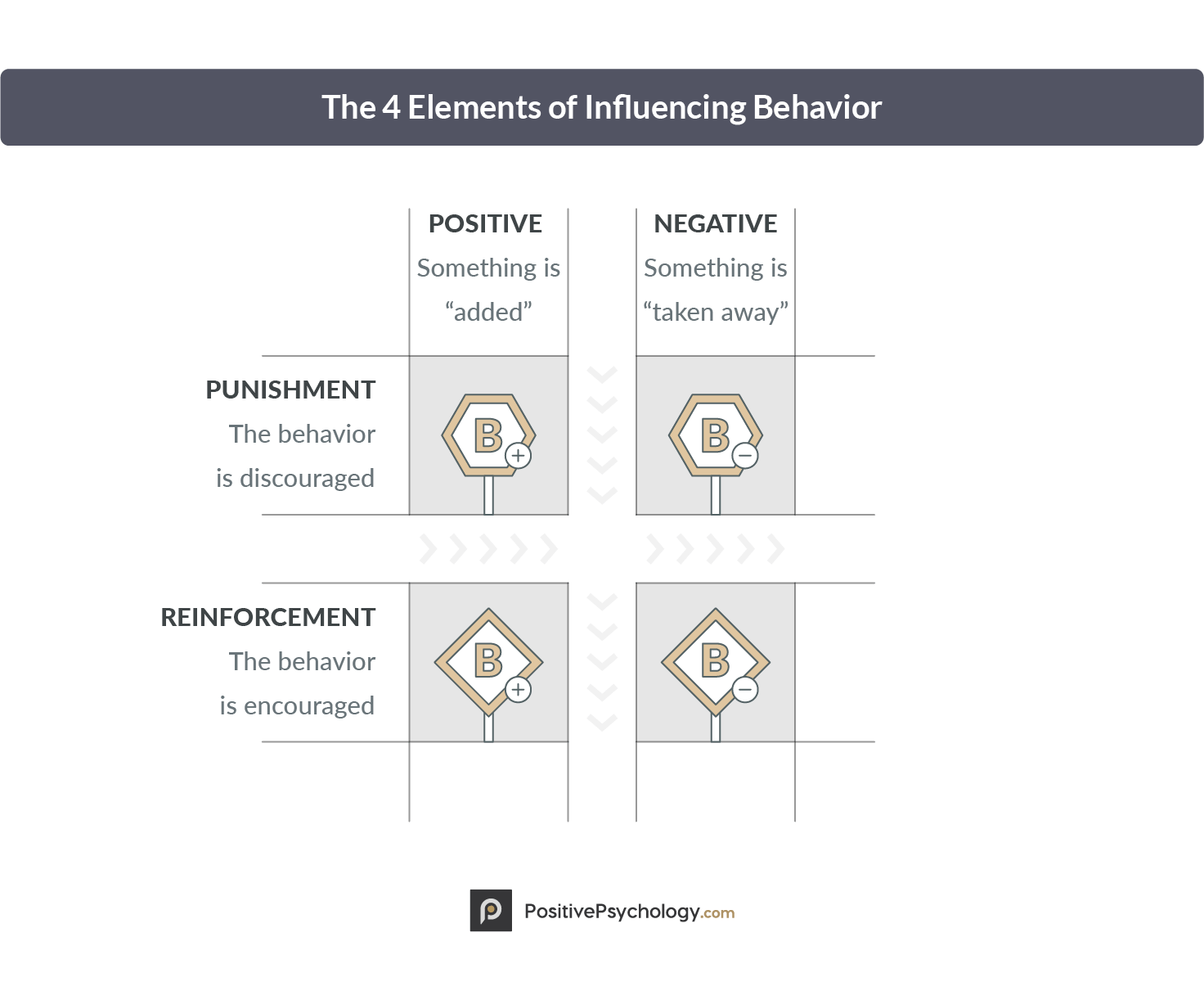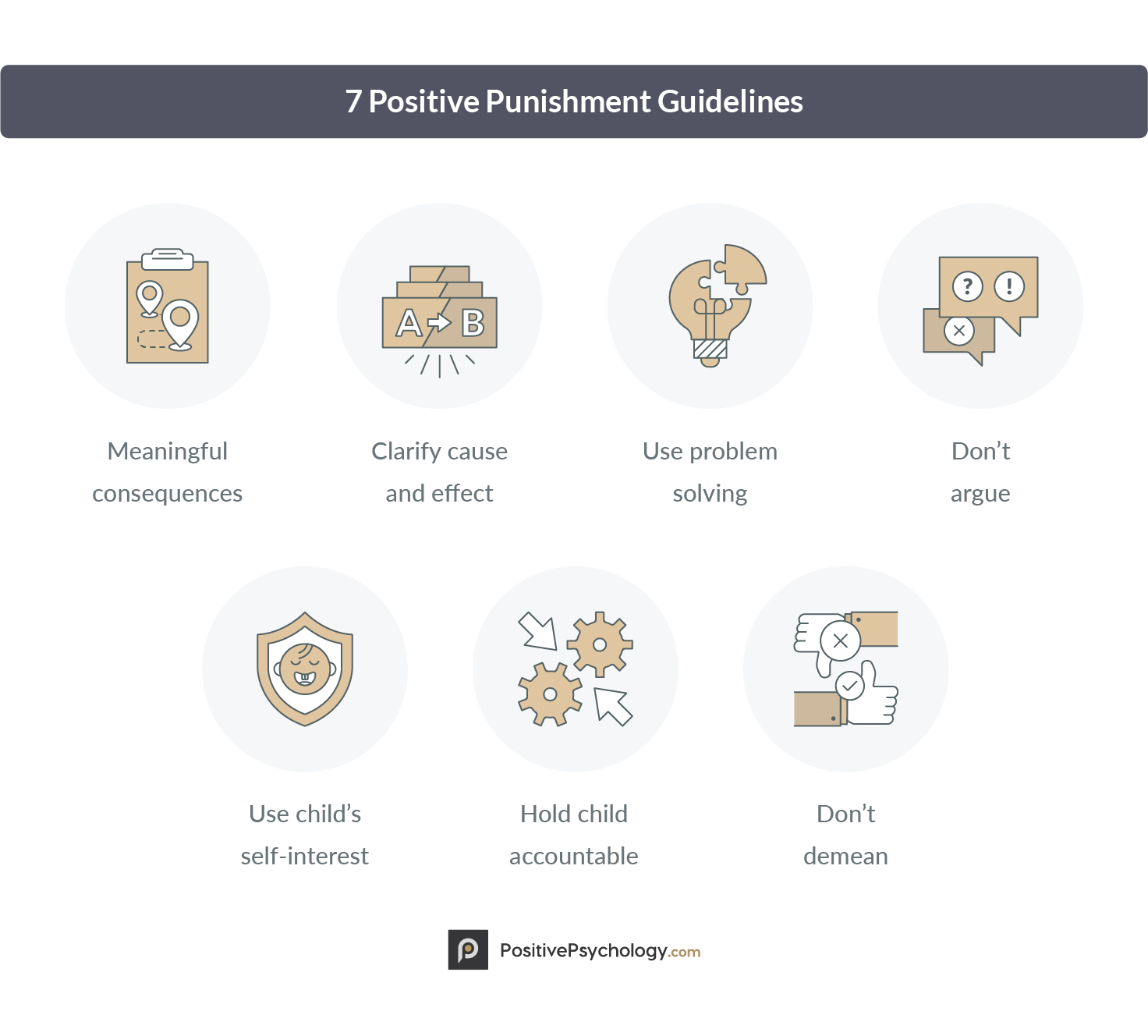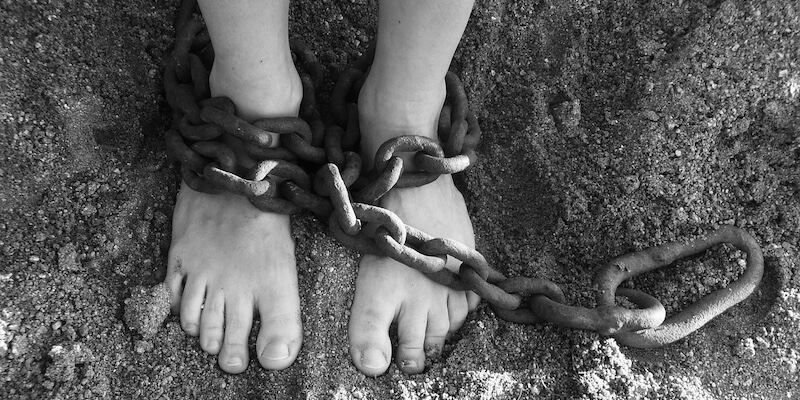12 Examples of Positive Punishment & Negative Reinforcement
 You might be thinking that “positive punishment” sounds like an oxymoron, after all, how can punishment be positive?
You might be thinking that “positive punishment” sounds like an oxymoron, after all, how can punishment be positive?
Not many people “like” punishment, right?
The disconnect in understanding this concept comes from the usage of the word “positive;” here at PositivePsychology.com, we generally use the term “positive” to refer to things that are inherently good, things that are life-giving, and things that promote thriving and flourishing.
The concept of positive punishment comes from a very different era and a very different perspective on psychology; namely, the 1930s and behaviorism.
So, what actually is positive punishment and how does it relate to parenting, teaching, and even the workplace?
Before you continue, we thought you might like to download our three Positive Relationships Exercises for free. These detailed, science-based exercises will help you or your clients build healthy, life-enriching relationships.
This Article Contains:
- What is Positive Punishment in Psychology?
- B.F. Skinner and His Operant Conditioning Theory
- Positive Punishment vs. Negative Reinforcement
- Positive Punishment vs. Positive Reinforcement
- 6 Examples of Positive Punishment in Practice
- 6 Examples of Negative Reinforcement in Practice
- The Positive Effects of Punishment
- Using Positive Punishment with Children
- Applying Positive Punishment in the Classroom
- Positive Punishment in the Workplace
- Common Criticisms
- A Take-Home Message
- References
What is Positive Punishment in Psychology?
Positive punishment is one of four (positive parenting) methods of modifying behavior according to the theory of operant conditioning (Skinner, 1971). The four types are:
- Positive punishment
- Positive reinforcement
- Negative punishment
- Negative reinforcement
These methods are categorized based on two factors:
- Whether you are trying to encourage (reinforce) or discourage (punish) behavior.
- Whether you are adding something to influence behavior (positive) or taking something away to influence behavior (negative).
Although it can be difficult to see “positive” as discouraging behaviors and “negative” as encouraging behaviors, it’s easy to catch on when you realize that, when it comes to operant conditioning, the terms “positive” and “negative” are not used in the manner we generally think of them. In this theory, “positive” doesn’t necessarily mean “good” and “negative” doesn’t necessarily mean “bad.”
B.F. Skinner’s Operant Conditioning Theory
The theory of operant conditioning was developed by famed behaviorist B. F. Skinner (1971). If you’re not familiar with behaviorism, it’s definitely worth a dive into the literature; however, for the purposes of this piece, we’ll give a brief overview.
Behaviorism was the guiding perspective on psychology for several decades, from around the 1930s to the 1960s. It was championed by John Watson, but Skinner is the psychologist most often associated with behaviorism thanks to his many theories and experiments (GoodTherapy, 2015). The general idea behind behaviorism is that people (and animals) are heavily influenced and directed by outside factors. In the “nature vs. nurture” debate, behaviorists fall firmly on the “nurture” side.
The more hardline behaviorists believed that humans are born as “blank slates” with virtually no pre-existing programming or inherent characteristics. According to them, just about everything that you could use to describe yourself—whether that is traits, skills, titles, or preferences—comes from your environment. In this view, we are all born with roughly equal potential, barring genetic disorders and other physical limitations or advantages.
It was in this vein that Skinner developed his theory of operant conditioning. This theory holds that classical conditioning—the phenomenon by which Pavlov discovered that we associate things that happen sequentially as causally related—is too simplistic to explain how behavior is usually influenced, particularly the more complex behaviors (McLeod, 2018).
Operant conditioning is built on the foundation of rewards and punishment: when our behavior is rewarded, we are encouraged to repeat or continue that behavior, and when our behavior is punished, we are discouraged from repeating or continuing that behavior.
We form an association between the behavior we exhibited and the consequence, whether good or bad. When we are encouraged and rewarded for a behavior, that behavior is reinforced; when we are punished for a behavior, that behavior tends to die out (McLeod, 2018).
As we noted above, operant conditioning outlines four ways of influencing behavior based on the consequence and the desired result:
- Positive punishment: something is “added” to the mix that makes the behavior less likely to continue or reoccur (i.e., an unpleasant consequence is introduced to the subject to discourage their behavior).
- Positive reinforcement: something is added to the mix that makes the behavior more likely to continue or reoccur (i.e., a pleasant consequence is introduced to the subject to encourage their behavior).
- Negative punishment: something is “taken away” from the mix that makes the behavior less likely to continue or reoccur (i.e., something pleasant is removed from the subject to discourage their behavior).
- Negative reinforcement: something is taken away from the mix that makes the behavior more likely to continue or reoccur (i.e., something unpleasant is removed from the subject to encourage their behavior).
Some examples of these methods of influencing behavior will be outlined below.
Positive Punishment vs. Negative Reinforcement
Positive punishment is an attempt to influence behavior by adding something unpleasant, while negative reinforcement is an attempt to influence behavior by taking away something unpleasant. Both methods are employed to influence behavior, but positive punishment looks to remove or decrease a “bad” behavior while negative reinforcement seeks to encourage or increase a “good” behavior.
For example, spanking a child when he throws a tantrum is an example of positive punishment. Something is added to the mix (spanking) to discourage a bad behavior (throwing a tantrum).
On the other hand, removing restrictions from a child when she follows the rules is an example of negative reinforcement. Something unpleasant (a set of restrictions) is removed to encourage the child’s good behavior (following the rules).
Positive Punishment vs. Positive Reinforcement

In both cases, something is added to the mix, whether it is something pleasant (positive reinforcement) or something unpleasant (positive punishment).
As listed above, positive punishment involves adding something unpleasant to discourage a behavior. Positive reinforcement involves adding something pleasant to encourage a behavior.
For example, treating a child to an ice cream cone when he stays quiet and obedient during a shopping trip is positive reinforcement. The child’s behavior (being quiet and obedient while out shopping) is reinforced by adding something pleasant (an ice cream cone). Hopefully, the child will understand that he is getting an ice cream cone because he behaved himself on the shopping trip, and he will be more likely to behave himself on the next shopping trip.
For more on this, please see positive reinforcement for kids.
6 Examples of Positive Punishment in Practice
There are many more ways to use positive punishment to influence behavior, including:
- Yelling at a child for bad behavior.
- Forcing them to do an unpleasant task when they misbehave.
- Adding chores and responsibilities when he fails to follow the rules.
- Assigning students who forget to turn in their assignment extra work.
- Adding extra sensitivity training to employees who offend or harass someone at work.
- Implementing more rules and restrictions when a teen misses curfew.
Not all of these punishments are necessarily good ways to discourage behavior, but they are examples of the concept of positive punishment.
6 Examples of Negative Reinforcement in Practice
There are also many examples of negative reinforcement in practice (with varying degrees of effectiveness), including:
- Removing strict parental controls on the internet or tv when a child proves herself responsible enough to handle more mature content.
- Allowing a child to go out without a chaperone when she stops pushing the boundaries of her parents’ rules.
- Removing responsibility for a household chore in order to reward a child for completing her other chores to her parents’ satisfaction.
- Removing the curfew when a teenager has proven she is responsible and practices common sense.
- Removing obstacles to autonomy (e.g., rigid timelines or prescribed ways of carrying out tasks) when an employee successfully completes an important project.
- Abolishing the practice of clocking in and out when employees have proven they can be trusted to accurately report their time worked.
Examples of positive and negative reinforcement and punishment – The Movement System
The Positive Effects of Punishment
Although “punishment” sounds inherently negative, it’s not necessarily a negative thing. In operant conditioning, punishment is simply the discouragement of a behavior; it can be as benign as sitting a child down and explaining to them why they should no longer engage in a bad behavior.
The positive outcomes of using punishment include:
- The child is informed that their behavior is not acceptable, and now knows what not to do in the future.
- The child is given a punishment or negative consequence, which teaches her that behavior has consequences and will hopefully help her associate the two.
- The child is given a good reason to behave more appropriately in the future, and eventually should be given an opportunity to do so.
Of course, there are some downsides to punishment as well:
- Punished behavior is not necessarily forgotten, just suppressed, meaning that it may return when the punishment is no longer implemented.
- It may cause increased aggression and teach the child that aggression is a good way to solve problems (only with certain types of punishment).
- It can create fears that generalize to other situations (e.g., a child who is punished for being disruptive may withdraw and begin to fear social situations).
- It does not always guide the child toward the desired behavior; it tells the child what not to do, but may not tell the child what he or she should do instead (McLeod, 2018).
Ideally, a child would be raised with both reinforcement and punishment in a healthy mix—receiving rewards for good behavior and being corrected for bad behavior. Often, both are vital pieces of parenting and each can accomplish what the other fails to accomplish.
For example, reinforcement is a great tool for encouraging good behavior, but it gives the child no feedback on bad behavior (although sometimes the bad behavior is simply the opposite of the good, like adhering to the curfew vs. breaking the curfew). Likewise, punishment is good for discouraging bad behavior, but it has the unfortunate flaw of telling the child nothing about which behavior is actually desired.
Of course, these flaws in each method largely disappear when parents employ both methods and are communicative about what they expect to see and what they expect not to see from their child.
Using Positive Punishment with Children
Positive punishment can be an extremely effective tool in the parents’ toolbox, and as we learned above, it doesn’t have to be physical. Positive punishment describes any situation in which parents add something that is undesirable to the child in order to encourage them to refrain from a specific behavior they do not consider appropriate or acceptable.
There are many ways to do this. James Lehman, social worker and expert on working with troubled youth, offers these seven guidelines for using positive punishment:
- Use consequences that have meaning.
They should be unpleasant and attached to the behavior they exhibited and the lesson you want them to learn (e.g., being rude to someone may result in having to write a letter of apology for being rude and an explanation of what they will do next time they get angry instead of lashing out). - Make consequences black and white.
Show your child that behavior A leads to consequence B, no matter why they engaged in behavior A or how they feel about the fairness of consequence B. - Have conversations about problem-solving.
Depending on the degree of unpleasantness, this may be punishment in itself, but it can be used as a supplement to a punishment as well (e.g., a teenager is punished for missing curfew, but the parents also have a discussion with the teen about their options next time they are tempted to stay out late or in a situation where they may end up breaking curfew). - Don’t get sucked into an argument over the consequences.
Be firm in your decision and don’t be swayed by a young child’s tantrums or a teenager’s (supposed) apathy about the punishment. - Engage your child’s self-interest.
You can do this by encouraging them to answer the question “What are you going to do so you don’t get in trouble next time?” Children will never want positive punishment (unless it’s an inherently ineffective punishment), so getting them to think about how to avoid that punishment will help encourage better behavior. - Hold your child accountable for their own behavior.
Even if they don’t seem like they care about the punishment, it is their behavior that is important, not how much they seem to care. - Don’t show disgust or disdain or be sarcastic with your child.
The point is to teach your child, not demean or discourage them (Lehman, 2012).
However, there are limits on how and when to use positive punishment; according to James Lehman, grounding your child will only teach them how to “do time,” but it doesn’t actually show them how to improve their behavior (Lehman, 2012). Kids that are frequently grounded will eventually get used to it and learn to cope with it, but they won’t necessarily learn what you’re trying to teach them (see our post on building resilience in children).
Instead of providing them with instruction on appropriate behavior and a chance to do better, grounding a child restricts their behavior and keeps them from even having a choice about whether to behave in the desired manner or not. They may feel so restricted that it leaves them with no opportunity to evaluate their choices and make better decisions, giving them no room to grow.
Research also shows that positive punishment does not always weaken a person’s behavior when punished, it may simply suppress it. If a child fears being punished, they may continue to engage in the bad behavior while they are away from the parent(s) who punishes them. Children will behave when you are looking because they don’t like the punishment, but they may still enjoy secretly engaging in the behavior itself (Smith, 2012).
Applying Positive Punishment in the Classroom

There may be less leeway since teachers generally do not have the same authority over children that their parents do, but there is also an added element that can help or harm efforts to use positive punishment: the presence of their peers.
Peer pressure is a highly impactful factor that can be harnessed to normalize and encourage good behavior, but punishing children in front of their peers can also cause shame, embarrassment, and seething resentment when applied incorrectly.
One of the most important rules to follow when it comes to positive punishment in the classroom is to refrain from using shame or embarrassment as a tool for learning; if a child is embarrassed in front of her peers, she is not likely to think of it as a positive learning experience and may become openly hostile instead of being encouraged to evaluate her own behavior and make better choices.
Along with this important rule, follow these six guidelines to ensure positive punishment is used effectively and appropriately in the classroom:
- Pair positive punishment with positive reinforcement to provide encouragement for desirable behaviors with which students can replace their bad behavior.
- Use the mildest punishment techniques that are likely to be effective; start off with less intense punishments and work your way up as needed if the mild techniques are ineffective.
- Do not deprive the student of key opportunities to build their social and academic skills; for example, avoid reducing recess time or handing out suspensions if the child is already awkward with peers or finds it difficult to make friends.
- Allow students to provide input on any behavior plans being developed; this way, the students will feel they have a voice and will be more likely to accept any punishments they earn.
- Make sure your plan for encouraging good behavior and discouraging bad behavior is congruent with:
a. Your country, state, or territory regulations, and
b. Your students’ parents! - Monitor the effects of your behavior plan to ensure it is working and troubleshoot anything that is not working (Intervention Central, n.d.).
Positive punishment can be a very useful tool in the classroom when applied conscientiously and with careful consideration.
Positive Punishment in the Workplace
Punishment doesn’t necessarily stop when we become adults.
The idea that punishment can be effective in stopping undesirable employee behaviors, such as tardiness and absenteeism, is a popular one. It’s something you’ve likely seen in your own workplace, either directed towards yourself or someone else.
For example, these are all instances of positive punishment at work:
- Being verbally scolded by your boss, or perhaps by your Human Resources department.
- Being assigned extra training when you break the rules or behave in an unprofessional manner.
- Being assigned the tasks no one wants to do for failing to produce quality work on time.
- Receiving an official warning for calling off work too often.
In some cases, these forms of punishment can be extremely effective. Sometimes all it takes to discourage bad behavior and encourage good behavior is a “talking to” from your manager. Other times, it’s not so effective.
Research has shown that positive punishment doesn’t always bring about good behavior at work; sometimes, it only temporarily stops one bad behavior from happening and may also lead to fear, psychological tension, anxiety, and other undesirable outcomes. These emotional and behavioral responses are likely to negatively impact work productivity and work behavior (Milbourn Jr., 1996).
Similar to the consequences of overzealous or unnecessarily harsh parenting techniques, employees who feel as if they have no choice or control over their work may begin to act out, repress their true intentions, or even engage in more nefarious behavior like embezzling, sabotage, or otherwise undermining their employer.
Positive punishment at work may be effective in some cases, but like positive punishment for children, it should be used sparingly, appropriately, and in conjunction with reinforcement techniques.
Common Criticisms
As we covered earlier, there are some definite downsides to positive punishment; it can confuse children about what they should be doing instead of the bad behavior, cause them to develop fears or other maladaptive habits or feelings, cause anger or rebelliousness, and may only lead to suppression of the behavior instead of true “extinction” of the behavior.
These are some common criticisms of the effectiveness of positive punishment, but there are also some quite strong aversions to positive punishment for another reason: whether it is ethical or not.
Many modern parents are averse to any type of positive punishment that involves unpleasant physical consequences, and for good reason—a large body of research shows that physical punishment may not only be ineffective in many cases, it may also result in unintended consequences or even backfire on the parents (Cherry, 2018).
A recent meta-analysis of several decades’ worth of research on spanking and other physical punishments largely considered not to be abusive showed that these punishments made a child significantly more likely to display undesirable and unintended consequences, such as anti-social behavior and mental health problems (Gershoff & Grogan-Kaylor, 2016). In fact, the effects of spanking and other “non-abusive” forms of physical punishment were observed to be almost as detrimental as physical abuse.
As Alan Kazdin, a psychology professor at Yale University and expert on parenting notes:
“You cannot punish out these behaviors that you do not want… there is no need for corporal punishment based on the research. We are not giving up an effective technique. We are saying that this is a horrible thing that does not work” (Smith, 2012).
A Take-Home Message
The bottom line is that, like many other techniques and methods, positive punishment can be very effective or very ineffective depending on how it is applied.
Positive punishment that is appropriately targeted and matches the level of the infraction can be a great tool to discourage or extinguish behavior; inappropriately targeted and mismatched positive punishment can result in everything from failing to teach the lesson you want to teach to mental health problems and the continuation of parenting styles that simply do not work.
If you use common sense and follow the easy-to-understand guidelines in this article, you should have no major trouble using mild, effective positive punishment to encourage good behavior.
What do you think about positive punishment? Do you find it effective for your children, students, and/or employees? What are your go-to punishments or reinforcements? Let us know in the comments!
Want to keep reading? Check out: Positive Parenting Books, Training and Resources
We hope you enjoyed reading this article. Don’t forget to download our three Positive Relationships Exercises for free.
- GoodTherapy. (2015). “Behaviorism”. Retrieved from https://www.goodtherapy.org/learn-about-therapy/types/behaviorism
- Gershoff, E. T., & Grogan-Kaylor, A. (2016). Spanking and child outcomes: Old controversies and new meta-analyses. Journal of Family Psychology, 30, 453-469.
- Intervention Central. (n.d.). What every teacher should know about punishment techniques and student behavior plans. Retrieved from https://www.interventioncentral.org/behavioral-interventions/challenging-students/what-every-teacher-should-know-about…punishment-techni
- Lehman, J. (2012). Kids who ignore consequences: 10 ways to make them stick. Empowering Parents. Retrieved from https://www.empoweringparents.com/article/kids-who-ignore-consequences-10-ways-to-make-them-stick/
- McLeod, S. (2018). Skinner – Operant conditioning. Simply Psychology. Retrieved from https://www.simplypsychology.org/operant-conditioning.html
- Milbourn, Jr., G.. (1996). Punishment in the workplace creates undesirable side effects. Wichita Business Journal. Retrieved from http://www.bizjournals.com/wichita/stories/1996/11/18/focus3.html
- Skinner, B. F. (1971). Operant conditioning. The Encyclopedia of Education, 7, 29-33.
- Smith, B. L. (2012). The case against spanking. American Psychological Association 43(4), Monitor on Psychology, 60. Retrieved from http://www.apa.org/monitor/2012/04/spanking.aspx
Let us know your thoughts
Read other articles by their category
- Body & Brain (49)
- Coaching & Application (57)
- Compassion (26)
- Counseling (51)
- Emotional Intelligence (24)
- Gratitude (18)
- Grief & Bereavement (21)
- Happiness & SWB (40)
- Meaning & Values (26)
- Meditation (20)
- Mindfulness (45)
- Motivation & Goals (45)
- Optimism & Mindset (34)
- Positive CBT (28)
- Positive Communication (20)
- Positive Education (47)
- Positive Emotions (32)
- Positive Leadership (18)
- Positive Parenting (4)
- Positive Psychology (33)
- Positive Workplace (37)
- Productivity (16)
- Relationships (46)
- Resilience & Coping (36)
- Self Awareness (21)
- Self Esteem (37)
- Strengths & Virtues (31)
- Stress & Burnout Prevention (34)
- Theory & Books (46)
- Therapy Exercises (37)
- Types of Therapy (64)







What our readers think
Positive punishment is so important. It helps your kids learn the hard way so they become good kids with good thought! DO BETTER AND BE GOOD PARENTS!!!!!
It was very important and helpful. Thank you
It was very helpful, informative and gave me a lot of clarity on the topics I was seeking. Thank you for your efforts and time. It was worth it.
This research is clearly posted. thank you very much
This article is well researched. Thanks a lot
Referring to Jeff’s comment about grounding, by definition, being a removal, I’d like to point out that a child confined to his room, a classic “grounding” can easily be a the definition of a positive punishment because confinement is added. Unlike math, this real world example, it adding confinement with nothing to entertain can also easily be both an added restriction or confinement as well as a removal of normal freedoms, diversions and privileges. A number cannot be both 3 and -3 but a consequence can be something added and something (the opposite opportunity) removed. It is the nature of language that descriptions can have ambiguity with regard to this strictly operant-conditioning definition of the words “positive” and “negative.” I content this is why these ideas are so commonly misunderstood, difficult to correctly apply and falling from use.